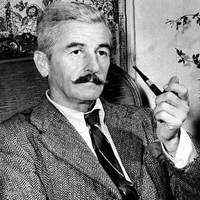Faulkner's As I Lay Dying as a Modern Text
As I Lay Dying, a novel by William Faulkner, exploits a variety of distinct features typical of modernist text. Unlike the traditional trend of writing, it possesses different themes, techniques, subject matter and characters, on the foundation of which the novel stands as a modernist text.

William Faulkner (1897-1962)
At the level of theme, the novel exploits a number of modernist features. Alienation is one salient feature of the modern novel, which ranks at the top in this novel. There are levels of alienation in the novel, which keep almost all the characters totally isolated from one another though they work together and live together. Since every individual life locked in the 'cell' of his/her own consciousness, he/she cannot penetrate into the loneliness of another. Anse Bundren, for example, lacks the sense of responsibility to his family to such an extent that keeps himself isolated from the other members of the family. His disinterestedness to enjoyment and merry-making further intensifies his alienation.
Addie Bundren, Anse's wife, on the other hand, is highly isolated because of her own belief and behaviour. She was taught by her father that the aim of living is to prepare for death. That is why, perhaps, she does not believe in love and motherhood, which makes her alienated from her own children. And, it was also her act of committing adultery that makes her isolated from her husband and others. Addie's second son Darl is another victim of alienation. He is a highly sensitive person who knows about his mother's immoral relationship with the preacher Whitfield, and his sister's illegitimate pregnancy. That is why his mother and sister are afraid of him; and he, too, keeps himself aloof from them. Similarly, his brother Cash doesn't want to trouble other's job, so he is also alienated.
Not only one individual is alienated from the other, but they are also alienated from God, or from the sense of religion. They seem to believe in the announcement of the death of God. A preacher named Whitfield, committing adultery, presents himself as a model of disbelief in religion. Likewise, Cora Tull, a former preacher, keeps on talking about gods, but for herself gods are nowhere but “in pocket.” In terms of setting too this novel is taken as a modernist text. The novel is set in Yoknapatawpha, a fictitious place Faulkner has created in which his 15 out of 19 novels are set. Yaknapatawpha is barely populated and the thin population lives in a long distance. The Tulls, Samsons, Armstids and Bundrens form a society, but they have physical alienation. One's house is too far from another. The novelist Faulkner has created the setting in such a way that it also reinforces the theme of isolation.
The Pain of living is another layer of theme to support the modernist mode of this novel. Here, we read pain in two levels: physical and mental. Poverty here is the cause of physical pain. Bundren family is so poor that even the death of a mother cannot prevent her sons from going to earnings. And while on the way to the graveyard, too, they cannot free themselves from their lowly 'business': buying false teeth by Anse through trickery, and so on. On the other hand, they have mental pain caused by void of life. There is no warm- heartedness, but a complete communication gap dominates the entire world of the novel. No one is of any value to anyone else. No one has a happy heart either. Meaninglessness and uncertainty make the entire panorama of the novel completely gloomy.
The novel, on the other hand, includes no historical, social, and political forces. The Characters are totally apolitical and ahistorical. Darl, for example, does not go to vote.
Similarly, at the level of technique, too there are certain modernist features in the novel. Under the stream of consciousness technique, it has fifty-nine interior monologue narrated in the perspectives of fifteen characters. The characters speak in the first person narrative, giving outlet to their conscious and half-conscious thoughts, memories, expectations, feelings and their random associations. The mental impact of death and destruction, pain and problem, and tension and isolation has got a suitable outlet of stream of consciousness technique. The characters speak their southern vernacular, which is highly metaphoric. They are so subjective that they plunge the readers within. There is fluid flow of a character's psyche.
The novel has a very simple subject matter. It covers almost not more than a nine-day long funeral procession participated by a poor family. It starts with Addie lying in deathbed, and ends with her final rite. No extraordinary happening is there. The novel even rejects the notion of traditional mode of characterization. Here, the characters are so ordinary that they have no recognition in terms of their nobility. They are picked up from the world in which there is no prosperity, dignity, togetherness, and morality.
In this way, William Faulkner, by depicting a minor world filled with worry and anxiety, pain and poverty, dream and despair, and making the characters speak the same through their 'stream of consciousness', has given his novel a modernist shape.
Literary Spotlight
Introduction of As I Lay Dying
Plot Summary of As I Lay Dying
Themes in Faulkner's As I Lay Dying
As I Lay Dying a Masterpiece of Faulkner
Symbols in Faulkner's As I Lay Dying
Faulkner's Style in As I Lay Dying
Narrative Technique in Faulkner's As I Lay Dying
Multiple Voices and Perspectives in As I Lay Dying
 |
bachelorandmaster.com |